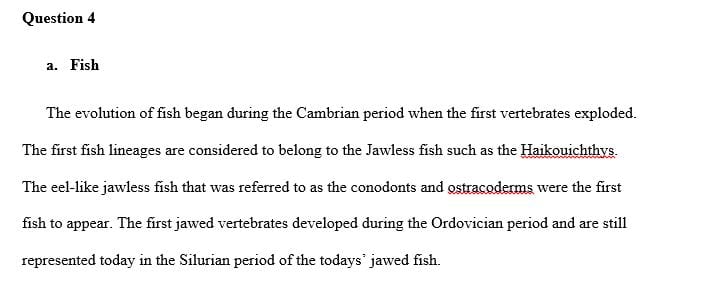Describe the major paleogeographic trends of the Cambrian period and how they affected patterns of sedimentation.
Geology short answer questions
EACH OF THE 4 QUESTION 150 WORDS OR SO
Directions: Select the Era that you studied. Answer four (4) of the following questions from option A, B or C. Be sure to answer in complete sentences. You may use diagrams to support your answers where appropriate.
A. Paleozoic Option:
1. Describe the major paleogeographic trends of the Cambrian period and how they affected patterns of sedimentation.
2. a) Why did greater carbonate deposition occur on the craton during the Ordovician and Silurian periods than during the Cambrian?
b) What evidence indicates that the Iapetus Ocean began closing during the middle Ordovician period?
3. Describe the origin and significance of
a) Silurian evaporates
b) Devonian-Mississippian black shales
c) Pennsylvanian cyclothems, and
d) Permian reefs
4. Discuss the Paleozoic evolutionary history of two of the following:
a) fish
b) amphibians
c) reptiles
d) vascular plants
5. a) How do scientists distinguish between reptiles and mammals?
b) How did the marine invertebrates of the late Paleozoic differ from those of the early Paleozoic?
6. Describe the mass extinctions at the end of the Permian period. What are some probable causes?
7. a) Describe the significance of BIFs, red beds, stromatoliites and oxygen content in the atmosphere.
b) Discuss how plate movements during the late Paleozoic affected world-wide
weather patterns.
B. Mesozoic Option:
1. a) What are the two main types of dinosaurs?
b) What is the physiological basis for this?
c) Discuss the evidence for and against the idea that the dinosaurs were warm- blooded.
2. What evidence supports the hypothesis that a meteorite impact might have caused the extinction at the end of the Mesozoic?
3. a) Describe the development of angiosperms from gymnosperms.
`b) Discuss the possible development of birds from dinosaurs. What characteristics do they have in common?
4. Explain the origin and development of mammals during the Mesozoic.
5. a) Discuss the major global plate tectonic events during the Mesozoic Era.
b) Describe the events that occurred during the breakup of Pangaea.
6. a) How does the breakup of Pangaea influence the Mesozoic distribution and development of plants and animals?
b) What effects did the breakup of Pangaea have on global climates and ocean circulation patterns?
7. Discuss the role that accretion of terranes played in the development of North America.
C. Cenozoic Option:
1. What type of continental margin is presently represented by the eastern edge of North America? How did it form? What types of sedimentation is this margin experiencing?
2. What kinds of Paleogene and Neogene deposits are found in North America’s continental interior? What was the source of these sediments?
3. Discuss the formation of the Basin and Range Province of North America. How is it different from typical orogenic belts?
4. a) How did continental glaciations affect areas far away from ice sheets? What were some of these effects?
b) Explain the concept of isostatic rebound, and cite evidence for rebound that has occurred since the end of the Pleistocene.
5. a) Compare and contrast erosional and depositional glacial landforms. How do they form? Give at least two examples of each.
b) Discuss the history of glacial Lake Missoula.
c) Explain Milankovitch’s Theory of climate change.
6. a) Discuss the development of small mammals during the Cenozoic.
b) Where were marsupials most abundant during the Cenozoic Era? What has been their fate thus far?
c) Compare and contrast placental mammals, marsupials, and monotremes.
7. What is the significance of the Paleocene-Eocene Thermal Maximum?
8. a) The aquatic mammals include the orders Sirenia and Cetacea. Discuss the development of these aquatic mammals during the Eocene.
b) How did the cephalopods of the Cenozoic seas differ from the cephalopods of the Mesozoic?
Answer preview to describe the major paleogeographic trends of the Cambrian period and how they affected patterns of sedimentation.

601 Words

